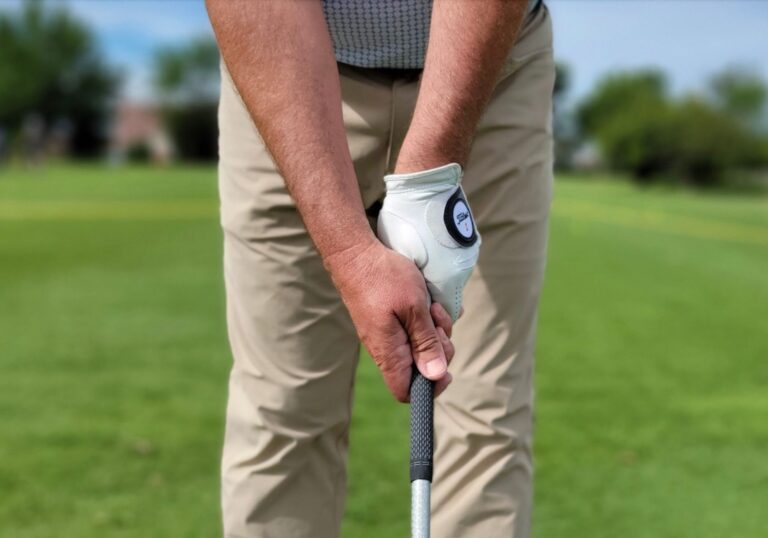If you’re new to golf, it’s easy to get overwhelmed by swing tips. Everyone’s got advice, from your buddy who plays once a month to the internet swing guru with three slow-mo videos and a launch monitor.
But here’s the truth: great swings start with great fundamentals. No gimmicks. No magic. Just proper grip, stance, and posture. Nail those, and you’re setting yourself up for a smoother, more consistent swing — whether you’re at the range or staring down your first tee shot.
Let’s break it down, one piece at a time.
The Grip: Your Only Connection to the Club
Your grip sets the tone for everything in your swing. If it’s off — too strong, too weak, too tight — it can throw off your clubface, tempo, and even your swing path.
There are three common grip styles:
- Overlap (Vardon) grip: Most popular. The pinky of your trail hand rests on top of the gap between the index and middle finger of your lead hand.
- Interlock grip: Pinky and index fingers interlock. Popular with players who have smaller hands (or Tiger Woods).
- Ten-finger (baseball) grip: All ten fingers on the club. Great for beginners, juniors, or those with less hand strength.
No matter which you choose, focus on these fundamentals:
- Lead hand (top hand): The club should run diagonally across your fingers, not your palm. Your thumb should rest slightly right of center (for right-handed players).
- Trail hand (bottom hand): Covers the lead thumb. The “V” formed by your thumb and index finger should point to your trailing shoulder.
- Grip pressure: Think “firm handshake,” not death grip. Tension kills swing speed and feel.
Quick test: Hold the club at address and let your arms dangle. If your hands, wrists, and forearms feel soft and relaxed, you’re probably in the right place.
The Stance: Balanced and Athletic

Your stance is your base. A good stance helps you stay balanced, rotate properly, and generate power without losing control.
Here’s how to build it:
- Feet shoulder-width apart for most clubs. Slightly wider for driver, slightly narrower for wedges.
- Ball position:
- Wedges: center or slightly back
- Irons: center to forward
- Driver: just inside your front heel
- Weight distribution: Evenly balanced between both feet — maybe 55% on your lead foot at setup for irons. Avoid leaning back or forward.
One key to a good stance is feeling athletic. Think of how you’d stand if someone tossed you a basketball. You wouldn’t stand stiff-legged or flat-footed — you’d be balanced, with knees slightly bent and ready to move.
That’s exactly what your golf stance should feel like.
The Posture: Tall but Tilted

Posture helps set your spine angle — which controls your ability to rotate. Get it wrong, and your swing will fight itself from the start.
Here’s how to set up properly:
- Start standing tall, holding the club in front of you.
- Tilt forward from the hips, not the waist. Your rear should push back slightly, and your spine stays straight (not hunched).
- Let your arms hang naturally — you shouldn’t feel stretched or cramped.
- Slight bend in the knees, but avoid squatting. Think “unlocking” your knees, not crouching.
Your weight should rest over the balls of your feet — not your heels. If you feel like you could jump straight up from your setup, you’re in a good spot.
Quick posture check: If your back is rounded and your chin is tucked, you’re too hunched. If your arms feel like they’re reaching for the ball, you’re standing too far away.
Common Mistakes to Avoid
Here are a few things beginners often struggle with — and how to avoid them:
- Gripping too tightly: Causes tension and robs you of feel and speed. Keep it light and relaxed.
- Standing too upright or too bent over: Both restrict your ability to turn. Use mirrors or videos to check your angles.
- Ball too far forward or back: Can lead to topped shots or chunks. Pay attention to your ball position for each club.
- Too much knee bend: Leads to a squatty, unbalanced swing. You’re not catching — you’re swinging.
Building a Solid Swing
Mastering grip, stance, and posture won’t win you the Masters — but it will build the foundation for a consistent, powerful swing. These are the first three things any coach will check when your game feels off — and for good reason. Everything else in your swing builds on them.
So take the time to get these basics right. Practice them at home in front of a mirror. Use slow-motion swings. Film yourself and compare it to a simple model. The more consistent you are here, the more confident you’ll feel when the club is actually in motion.
Because when grip, stance, and posture are automatic, the rest of the swing has a much better chance of falling into place.
